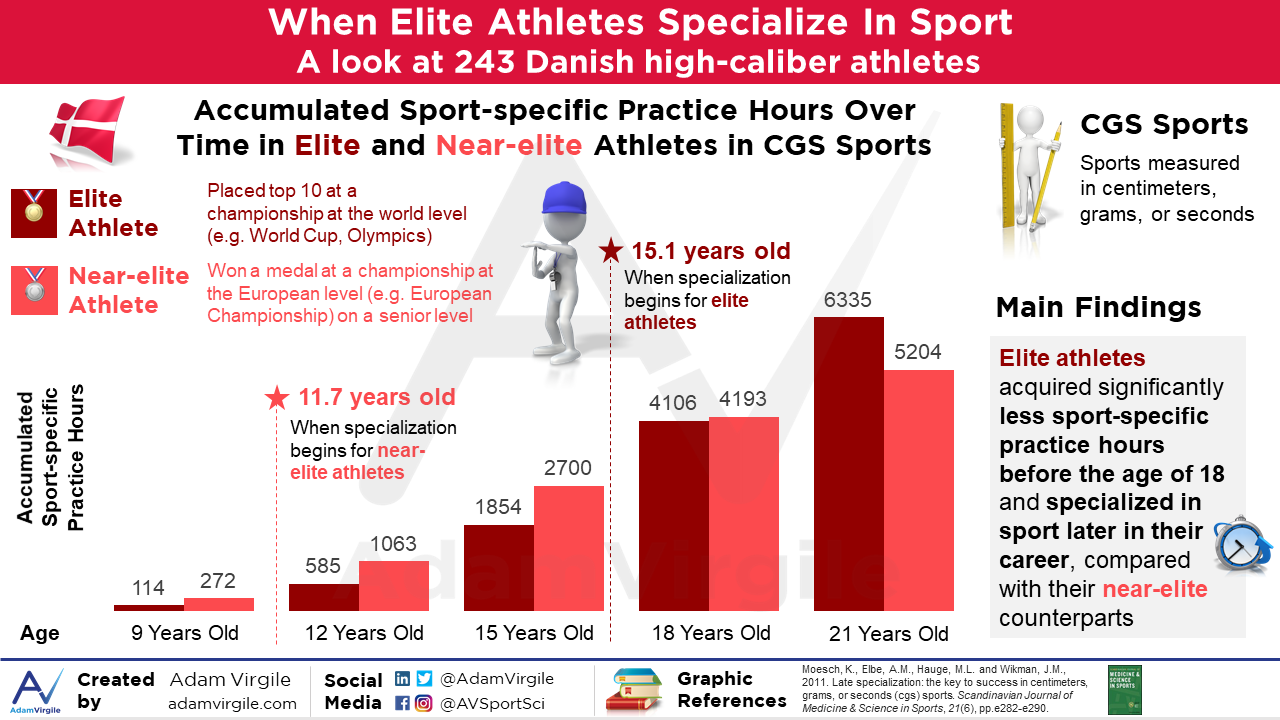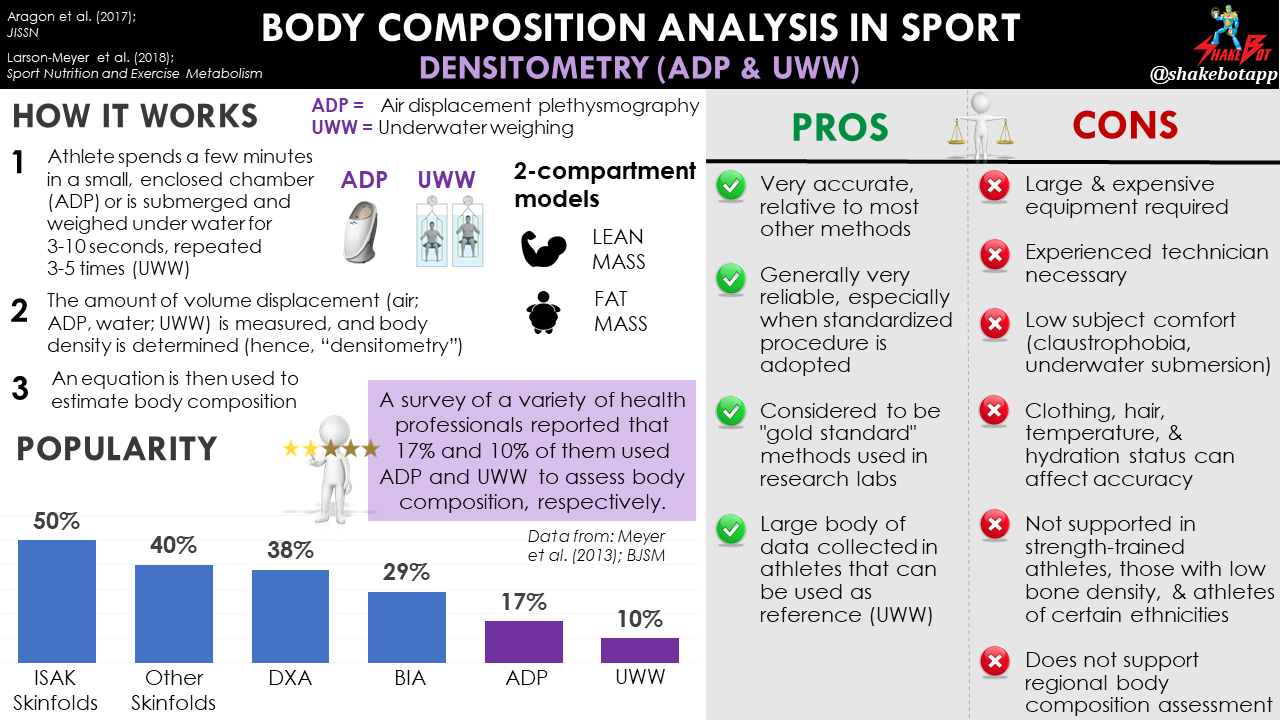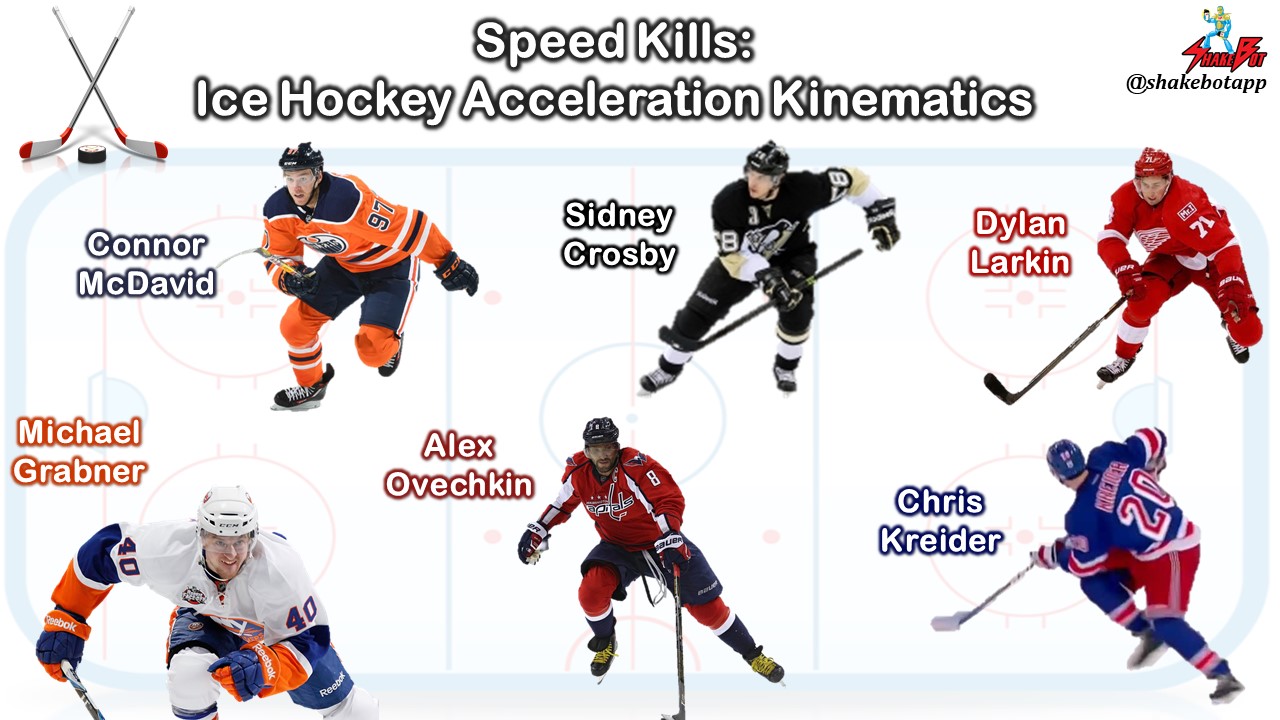Single sport specialization can be defined as intensive, year-round training in one sport to the exclusion of others [1]. Many young athletes, parents, and coaches believe that early single-sport specialization is necessary for long-term athletic success [2-6]. But, does the research agree with this notion?
In case you missed Part 1 of this article series where I dig through the research on the probabilities of attaining athletic success, you can view it here.
Early Sport Specialization and Immediate Athletic Success
Early specialization in a single sport appears to be a decent strategy for attaining youth athletic success. There are many reports suggesting that early single sport specialization and intensified, sport-specific practice/training during childhood (age ??12 years) and adolescence (13–18 years) correlate with youth athletic prowess [7-13]. On the surface, it appears that early sport specialization would be the ideal path for climbing up the ranks and, eventually, reaching sport performance at the highest level possible.
10,000 Hours of Deliberate Practice is All it Takes
In 2008, Malcolm Gladwell authored a book popularizing the “10,000 hour rule,” [14]. By studying the most successful business professionals and musicians throughout history and their paths to success, Gladwell suggested that the true mastery of a skill requires 10,000 hours of deliberate practice [14]. Others also believe that 10,000 hours of deliberate practice are necessary for sport mastery [15].
Many athletes and coaches report that it would be foolish to not specialize in a single sport early on because increased recognition, attainment of professional status, a college scholarship, or an Olympic qualification could result [16]. They may be right; let’s take a look at a few examples.
Tiger and “The Great One”
One of the world’s most renowned athletes, Tiger Woods, is a prime example supporting the advocates of early sport specialization [17]. At a mere 12 years of age, Tiger recorded his first round of 70 on a regulation golf course. At age 20 in 1996, Tiger became the first golfer to win three consecutive U.S. Amateur titles and won the NCAA individual golf championship [17]. Tiger’s early introduction to golf, deliberate practice at a very early age, a dominating parent in Earl Woods, a highly regulated life through childhood and adolescence into adulthood, and eventual extraordinary athletic success is a well-documented story [18].
The best ice hockey player of all time, Wayne Gretzky (”The Great One”), started playing hockey at the age of 2 years [19]. Between the ages of 3-12, Wayne reported frequently spending 8-10 hours per day on the ice [20]. At 6 years of age, Wayne had already developed a hyper-focus on the sport, and was so good that he played on a team of players who were 10 years old (nearly twice his age), at the time [19]. The Gretzky family arranged for Wayne to move from Ontario to Toronto when he was a mere 14 years of age, with the sole purpose of putting Wayne in a situation that would allow him to optimize his ice hockey career [19]. Today, Wayne Gretzky is considered “the greatest hockey player ever” by many sportswriters, players, and the league itself, following his illustrious 16-year professional career [21-24].
Tiger and Wayne Gretzky (“The Great One”) undoubtedly accrued 10,000 hours of deliberate practice early in their athletic careers and subsequently achieved sport mastery. They’re both notable examples of expert athletes who found remarkable success with extreme levels of deliberate practice, as suggested by Malcolm Gladwell.
Given this mindset, it’s no surprise that early sport specialization continues to (1) become more prevalent and (2) begin earlier during adolescence, as time moves forward [25-31]. Although Tiger Woods, Wayne Gretzky, and the 10,000-hour rule are prime anecdotes illustrating the rationale for destined success with early sport specialization, let’s take a peek at the other side of the coin, just for kicks.
Maybe It’s Not All That Practice at an Early Age
Yes Allen, we’re talking about practice. The 10,000 hour rule suggests that expert performance is largely the result of time spent in deliberate practice, or “engagement in structured activities created specifically to improve performance.” In a study by Macnamara et al. (2014), it was discovered that only 20% of sport performance could be attributed to time spent practicing the sport [32]. A frequently referenced article by Ericsson et al. (1993) contends that high volumes of deliberate practice are required to attain expert performance which is, most likely, a true statement [33]. However, the authors also state that “experts carefully schedule deliberate practice and limit its duration to avoid exhaustion and burnout.” It’s evident that this key aspect of their research is frequently overlooked or ignored. This is validated by the prevalence of early sport specialization, today.
There’s no question that accruing many hours of high-quality, deliberate practice is beneficial to achieving expertise, but not when it comes at the expense of youth development early in adolescence. In the following sections, it will become apparent that greater involvement in a variety of sports, before specializing in later stages of development, may lead to higher levels of athletic success, compared with early specialization in a single sport.
When High-Level Athletes Begin to Specialize
A survey of 148 elite and 95 near-elite Danish athletes (24.5 years old on average; track and field, weightlifting, cycling, rowing, swimming, skiing) found that the elite group of athletes began to specialize in their sport of choice ~3.5 years later and spent far fewer hours practicing its main sport during early adolescence (before 18 years old), compared with the near-elite group [34]. Another survey of 376 NCAA Division 1 female athletes found that the majority had their first organized sports experiences in sports other than their main sport [35]. In a small study of 4 Canadian Hockey League (CHL) athletes, the authors found that the athletes spent 2.5x more time participating in other organized sports, compared with ice hockey (1149 hours vs. 460 hours), between the ages of 6-12 years old [36]. It wasn’t until late adolescence that these elite hockey players began specializing in their main sport [36]. Carlson et al. (1988) found that elite tennis players began intense training and specialized later (after 13-15 years of age), compared with their near-elite counterparts, who began tennis specialization at 11 years old [37].
In a German study, 88% of Olympians reported participating in more than 1 sport as a child [38]. In another German study in 1558 elite athletes, the more successful athletes started training and competing in their specific main sport later [39]. Additionally, a higher percentage of the internationally successful top athletes were involved with other sports and maintained training in the other sport(s) until a higher age, as compared with the less successful athletes [39].
A large study conducted in the UK by Bridges and Toms (2013) investigated whether early specialization or sporting diversification (sampling) throughout childhood and adolescence influenced performance levels prior to adulthood [72]. In 1006 UK residents, a significant association between the number of sports participated in at the ages of 11, 13, and 15 and the standard of competition between 16 and 18 years was found. Individuals who competed in three sports aged 11, 13, and 15 were significantly more likely to compete at a national compared with club standard between the ages of 16 and 18 than those who practiced only one sport [72].
Baker et al. (2013) found that national level Australian athletes who participated in a wider breadth of sports required less time to acquire expertise in their primary sport, compared with their specialized counterparts [40]. The 2012 Olympic Champion Men’s Field Hockey (Germany) team did not differ from less-elite national class players in the total amount of hockey-specific practice/training, but had greater amounts of organized involvement in other sports and later specialization in field hockey [41]. In 2017, a study conducted in 73 elite senior Australian Track and Field athletes found that, between 13-15 years of age, the athletes spent nearly just as much time training for other sports as they did for their chosen sport (5.63 vs. 5.13 training hours/week) [42]. It wasn’t until they were 17.7 years old (on average) that they became specialized in their main T&F event [42]. These athletes either (1) competed at least once in an Olympic Games (between 1956 and 2012) or International Association of Athletic Federations (IAAF) World Track and Field Championships (between 1986 and 2013) [42].
In a recent study by Black et al. (2019), 91 professional male and collegiate ice hockey players completed a survey detailing their history of sports participation and specialization. On average, the athletes did not begin any sport participation until 4.5 years of age and did not specialize in ice hockey until 14.3 years of age [72]. A mere 11 of the 91 surveyed athletes (12%) specialized in ice hockey before 12 years of age, and most athlete participated in 2-4 sports during youth. In contrast to the Wayne Gretzkey mantra, these findings imply that early pediatric sports specialization before age 12 years is not necessary for athletic success in professional and collegiate ice hockey.
Overall, the results of these studies suggest that multi-sport participation is beneficial for for expert development [38-42, 72].
The beliefs of elite athletes reflect the aforementioned research findings. In a survey conducted in U.S. Olympians by Snyder (2014), 97% of athletes believed being a multi-sport athlete was beneficial to their success [43]. Buckley et al. (2017) found that 79.7% and 80.6% of current high school and collegiate athletes, respectively, thought that specializing in a single sport would help them play at a higher level [26]. In contrast, only 61.7% of professional athletes believed this to be true [26]. Similarly, in a survey of professional baseball players, 63.4% believed that early sport specialization was not required to play professional baseball [44].
Overall, World-Class and professional athletes were more likely to engage in multiple sports during childhood [34, 37, 40-44], and specialized in their primary sport significantly later [26, 37, 39-42]. These World-Class athletes were on to something; continuing to play other sports throughout development and well into adolescent years rather than early specialization appears to leads to greater success and longevity of elite sporting careers.
Does Early Sport Specialization Lead to Long-term Athletic Success?
Even if athletic success is attained at the youth level, research supporting its translation into long-term senior success is iffy, at best [45, 49-52]. In other words, early competitive athletic success is not a prerequisite, nor a valid predictor, of long-term athletic accomplishment. In fact, a recent review highlighted that the youth participation patterns that lead to youth success are quite different than those that facilitate long-term athletic development and adult success [53]. In most cases, long-term athletic development and adult success is the goal.
Although early single sport specialization and intensified, sport-specific practice/training during childhood and adolescence (5-18 years of age) have been associated with athletic success during youth [7-13], youth athletic prowess is not necessary, nor advised, for adult elite performance [54-57]. Taking this into account, multiple well-respected researchers and governing bodies advise avoidance of early sport specialization, due to many short and long-term health-related concerns [58-65]. A few of these concerns include athlete burnout, overuse injury, decreased enjoyment, limited physical and motor development, and even potential negative impact on the entire family [58-71].
In the next article, I’ll review the research surrounding injury risk and burnout in youth athletes who begin to specialize in a single sport during early adolescence.
UPDATE: You can view Part 3 here.
Reference
- Myer, G.D., Jayanthi, N., Difiori, J.P., Faigenbaum, A.D., Kiefer, A.W., Logerstedt, D. and Micheli, L.J., 2015. Sport specialization, part I: does early sports specialization increase negative outcomes and reduce the opportunity for success in young athletes?. Sports Health, 7(5), pp.437-442.
- Brooks, M.A., Post, E.G., Trigsted, S.M., Schaefer, D.A., Wichman, D.M., Watson, A.M., McGuine, T.A. and Bell, D.R., 2018. Knowledge, Attitudes, and Beliefs of Youth Club Athletes Toward Sport Specialization and Sport Participation. Orthopaedic journal of sports medicine, 6(5), p.2325967118769836.
- Voigt, L. and Hohmann, A., 2016. Expert youth coaches’ diversification strategies in talent development: A qualitative typology. International Journal of Sports Science & Coaching, 11(1), pp.39-53.
- Malina, R.M., 2010. Early sport specialization: roots, effectiveness, risks. Current sports medicine reports, 9(6), pp.364-371.
- Padaki, A.S., Ahmad, C.S., Hodgins, J.L., Kovacevic, D., Lynch, T.S. and Popkin, C.A., 2017. Quantifying Parental Influence on Youth Athlete Specialization: A Survey of Athletes’ Parents. Orthopaedic journal of sports medicine, 5(9), p.2325967117729147.
- Padaki, A.S., Popkin, C.A., Hodgins, J.L., Kovacevic, D., Lynch, T.S. and Ahmad, C.S., 2017. Factors that drive youth specialization. Sports health, 9(6), pp.532-536.
- Cathey, R.M., 2010. Retrospective practice histories of expert and novice baseball pitchers(Doctoral dissertation, University of South Carolina).
- Ford, P.R., Ward, P., Hodges, N.J. and Williams, A.M., 2009. The role of deliberate practice and play in career progression in sport: the early engagement hypothesis. High ability studies, 20(1), pp.65-75.
- Elferink-Gemser, M.T., Visscher, C., Lemmink, K.A. and Mulder, T., 2007. Multidimensional performance characteristics and standard of performance in talented youth field hockey players: A longitudinal study. Journal of sports sciences, 25(4), pp.481-489.
- Ford, P.R. and Williams, A.M., 2012. The developmental activities engaged in by elite youth soccer players who progressed to professional status compared to those who did not. Psychology of sport and exercise, 13(3), pp.349-352.
- Haugaasen, M. and Jordet, G., 2012. Developing football expertise: a football-specific research review. International Review of Sport and Exercise Psychology, 5(2), pp.177-201.
- Ward, P., Hodges, N.J., Williams, A.M. and Starkes, J.L., 2004. 11 Deliberate practice and expert performance. Skill acquisition in sport: Research, theory and practice, p.231.
- Weissensteiner, J., Abernethy, B., Farrow, D. and Müller, S., 2008. The development of anticipation: A cross-sectional examination of the practice experiences contributing to skill in cricket batting. Journal of Sport and Exercise Psychology, 30(6), pp.663-684.
- Gladwell M. Outliers: The Story of Success. New York, NY: Little, Brown and Company; 2008.
- Starkes, J.L. and Ericsson, K.A., 2003. Expert performance in sports: Advances in research on sport expertise. Human Kinetics.
- Wiersma, L.D., 2000. Risks and benefits of youth sport specialization: Perspectives and recommendations. Pediatric Exercise Science, 12(1), pp.13-22.
- http://tigerwoods.com/biography/
- Farrey T. Game On: The All-American Race to Make Champions of Our Children. New York: ESPN Books, 2008.
- Gretzky, W. and Reilly, R., 1990. Gretzky, an Autobiography. Harper & Collins.
- Duhatschek, Eric (January 14, 2014). “Duhatschek: In the City of Angels, NHL mends fences with The Great One”. The Globe and Mail. p. S1. Retrieved January 15,2014.
- “Wayne Gretzky”. Encyclopædia Britannica. Retrieved June 10,2008.
- Falla, Jack, “The Greatest One Bar None”, in Steve Dryden (ed.), The Top 100 NHL Players of All Time, p. 16.
- “Gretzky’s Awkward Arrival”. Time. Retrieved March 7,2008.
- Falla, Jack (2000). “Wayne Gretzky: Greatness Ascendant”. In Dan Diamond. Total Hockey: The Official Encyclopedia of the National Hockey League. Total Sports. ISBN978-1-892129-85-7.
- Jayanthi, N.A., LaBella, C.R., Fischer, D., Pasulka, J. and Dugas, L.R., 2015. Sports-specialized intensive training and the risk of injury in young athletes: a clinical case-control study. The American journal of sports medicine, 43(4), pp.794-801.
- Buckley, P.S., Bishop, M., Kane, P., Ciccotti, M.C., Selverian, S., Exume, D., Emper, W., Freedman, K.B., Hammoud, S., Cohen, S.B. and Ciccotti, M.G., 2017. Early Single-Sport Specialization: A Survey of 3090 High School, Collegiate, and Professional Athletes. Orthopaedic journal of sports medicine, 5(7), p.2325967117703944.
- Hill, G.M. and Simons, J., 1989. A study of the sport specialization on high school athletics. Journal of Sport and Social Issues, 13(1), pp.1-13.
- Metzl, J.D., 2002. Expectations of pediatric sport participation among pediatricians, patients, and parents. Pediatric Clinics of North America, 49(3), pp.497-504.
- Bell, D.R., Post, E.G., Trigsted, S.M., Hetzel, S., McGuine, T.A. and Brooks, M.A., 2016. Prevalence of sport specialization in high school athletics: a 1-year observational study. The American journal of sports medicine, 44(6), pp.1469-1474.
- Garland, W.J., 2017. Developmental Activities of Ontario Hockey League Players.
- Schwarb, A. W. (2016, April 19). After school specialized: Studies discourage specialization for young athletes. NCAA Champion Magazine, Spring. Retrieved from http://www.ncaa.org/champion/after-school-specialized
- Macnamara, B.N., Hambrick, D.Z. and Oswald, F.L., 2014. Deliberate practice and performance in music, games, sports, education, and professions: A meta-analysis. Psychological science, 25(8), pp.1608-1618.
- Ericsson, K.A., Krampe, R.T. and Tesch-Römer, C., 1993. The role of deliberate practice in the acquisition of expert performance. Psychological review, 100(3), p.363.
- Moesch, K., Elbe, A.M., Hauge, M.L. and Wikman, J.M., 2011. Late specialization: the key to success in centimeters, grams, or seconds (cgs) sports. Scandinavian journal of medicine & science in sports, 21(6), pp.e282-e290.
- Malina, R.M., 2010. Early sport specialization: roots, effectiveness, risks. Current sports medicine reports, 9(6), pp.364-371.
- Soberlak, P. and Cote, J., 2003. The developmental activities of elite ice hockey players. Journal of applied sport psychology, 15(1), pp.41-49.
- Carlson, R., 1988. The socialization of elite tennis players in Sweden: An analysis of the players’ backgrounds and development. Sociology of sport journal, 5(3), pp.241-256.
- Güllich, A., 2014. Selection, de-selection and progression in German football talent promotion. European Journal of Sport Science, 14(6), pp.530-537.
- Güllich, A. and Emrich, E., 2006. Evaluation of the support of young athletes in the elite sports system. European Journal for Sport and Society, 3(2), pp.85-108.
- Baker, J., Cote, J. and Abernethy, B., 2003. Sport-specific practice and the development of expert decision-making in team ball sports. Journal of applied sport psychology, 15(1), pp.12-25.
- Güllich, A., 2014. Many roads lead to Rome–Developmental paths to Olympic gold in men’s field hockey. European Journal of Sport Science, 14(8), pp.763-771.
- Huxley, D.J., O’Connor, D. and Larkin, P., 2017. The pathway to the top: Key factors and influences in the development of Australian Olympic and World Championship Track and Field athletes. International Journal of Sports Science & Coaching, 12(2), pp.264-275.
- Snyder, C., 2014. The Path to Excellence: A View on the Athletic Development of US Olympians Who Competed From 2000-2012. Colorado Springs, CO: Sport Performance and Coaching Education Division.
- Wilhelm, A., Choi, C. and Deitch, J., 2017. Early sport specialization: Effectiveness and risk of injury in professional baseball players. Orthopaedic journal of sports medicine, 5(9), p.2325967117728922.
- Güllich, A. and Emrich, E., 2014. Considering long-term sustainability in the development of world class success. European Journal of Sport Science, 14(sup1), pp.S383-S397.
- Güllich, A., 2017. International medallists’ and non-medallists’ developmental sport activities–A matched-pairs analysis. Journal of sports sciences, 35(23), pp.2281-2288.
- Hornig, M., Aust, F. and Güllich, A., 2016. Practice and play in the development of German top-level professional football players. European Journal of Sport Science, 16(1), pp.96-105.
- Rees, T., Hardy, L., Güllich, A., Abernethy, B., Côté, J., Woodman, T., Montgomery, H., Laing, S. and Warr, C., 2016. The great British medalists project: a review of current knowledge on the development of the world’s best sporting talent. Sports Medicine, 46(8), pp.1041-1058.
- Brouwers, J., De Bosscher, V. and Sotiriadou, P., 2012. An examination of the importance of performances in youth and junior competition as an indicator of later success in tennis. Sport Management Review, 15(4), pp.461-475.
- Schumacher, Y.O., Mroz, R., Mueller, P., Schmid, A. and Ruecker, G., 2006. Success in elite cycling: A prospective and retrospective analysis of race results. Journal of Sports Sciences, 24(11), pp.1149-1156.
- Barreiros, A., Côté, J. and Fonseca, A.M., 2014. From early to adult sport success: Analysing athletes’ progression in national squads. European Journal of Sport Science, 14(sup1), pp.S178-S182.
- Vaeyens, R., Güllich, A., Warr, C.R. and Philippaerts, R., 2009. Talent identification and promotion programmes of Olympic athletes. Journal of sports sciences, 27(13), pp.1367-1380.
- Araújo, D., Shuttleworth, R., Güllich, A. and Davids, K., 2017. Understanding environmental and task constraints on talent development: Analysis of micro-structure of practice and macro-structure of development histories. In Routledge Handbook of Talent Identification and Development in Sport(pp. 220-234). Routledge.
- Román, P.Á.L., Pinillos, F.G. and Robles, J.L., 2018. Early sport dropout: High performance in early years in young athletes is not related with later success. Retos: nuevas tendencias en educación física, deporte y recreación, (33), pp.210-212.
- Helsen, W.F., Starkes, J.L. and Hodges, N.J., 1998. Team sports and the theory of deliberate practice. Journal of Sport and Exercise psychology, 20(1), pp.12-34.
- Baker, J., Côté, J. and Deakin, J., 2005. Expertise in ultra-endurance triathletes early sport involvement, training structure, and the theory of deliberate practice. Journal of applied sport psychology, 17(1), pp.64-78.
- Kearney, P.E. and Hayes, P.R., 2018. Excelling at youth level in competitive track and field athletics is not a prerequisite for later success. Journal of sports sciences, pp.1-8.
- Brenner, J.S., 2016. Sports specialization and intensive training in young athletes. Pediatrics, 138(3), p.e20162148.
- Committee on Sports Medicine and Fitness, 2000. Intensive training and sports specialization in young athletes. Pediatrics, 106(1), pp.154-157.
- Jayanthi, N., Pinkham, C., Dugas, L., Patrick, B. and LaBella, C., 2013. Sports specialization in young athletes: evidence-based recommendations. Sports health, 5(3), pp.251-257.
- Feeley, B.T., Agel, J. and LaPrade, R.F., 2016. When is it too early for single sport specialization?. The American journal of sports medicine, 44(1), pp.234-241.
- LaPrade, R.F., Agel, J., Baker, J., Brenner, J.S., Cordasco, F.A., Côté, J., Engebretsen, L., Feeley, B.T., Gould, D., Hainline, B. and Hewett, T.E., 2016. AOSSM early sport specialization consensus statement. Orthopaedic journal of sports medicine, 4(4), p.2325967116644241.
- Smucny, M., Parikh, S.N. and Pandya, N.K., 2015. Consequences of single sport specialization in the pediatric and adolescent athlete. Orthopedic Clinics, 46(2), pp.249-258.
- DiFiori, J.P., Benjamin, H.J., Brenner, J.S., Gregory, A., Jayanthi, N., Landry, G.L. and Luke, A., 2014. Overuse injuries and burnout in youth sports: a position statement from the American Medical Society for Sports Medicine. Br J Sports Med, 48(4), pp.287-288.
- DiFiori, J.P., Güllich, A., Brenner, J.S., Côté, J., Hainline, B., Ryan, E. and Malina, R.M., 2018. The NBA and Youth Basketball: Recommendations for Promoting a Healthy and Positive Experience. Sports Medicine, pp.1-13.
- Brenner, J.S., 2007. Overuse injuries, overtraining, and burnout in child and adolescent athletes. Pediatrics, 119(6), pp.1242-1245.
- Merkel, D.L., 2013. Youth sport: positive and negative impact on young athletes. Open access journal of sports medicine, 4, p.151.
- Post, E.G., Trigsted, S.M., Riekena, J.W., Hetzel, S., McGuine, T.A., Brooks, M.A. and Bell, D.R., 2017. The association of sport specialization and training volume with injury history in youth athletes. The American journal of sports medicine, 45(6), pp.1405-1412.
- Russell, W.D. and Limle, A.N., 2013. The relationship between youth sport specialization and involvement in sport and physical activity in young adulthood. Journal of Sport Behavior, 36(1).
- Ferguson, B. and Stern, P.J., 2014. A case of early sports specialization in an adolescent athlete. The Journal of the Canadian Chiropractic Association, 58(4), p.377.
- Bean, C.N., Fortier, M., Post, C. and Chima, K., 2014. Understanding how organized youth sport may be harming individual players within the family unit: A literature review. International journal of environmental research and public health, 11(10), pp.10226-10268.
- Black, S., Black, K., Dhawan, A., Onks, C., Seidenberg, P. and Silvis, M., 2019. Pediatric Sports Specialization in Elite Ice Hockey Players. Sports Health, 11(1), pp.64-68.






